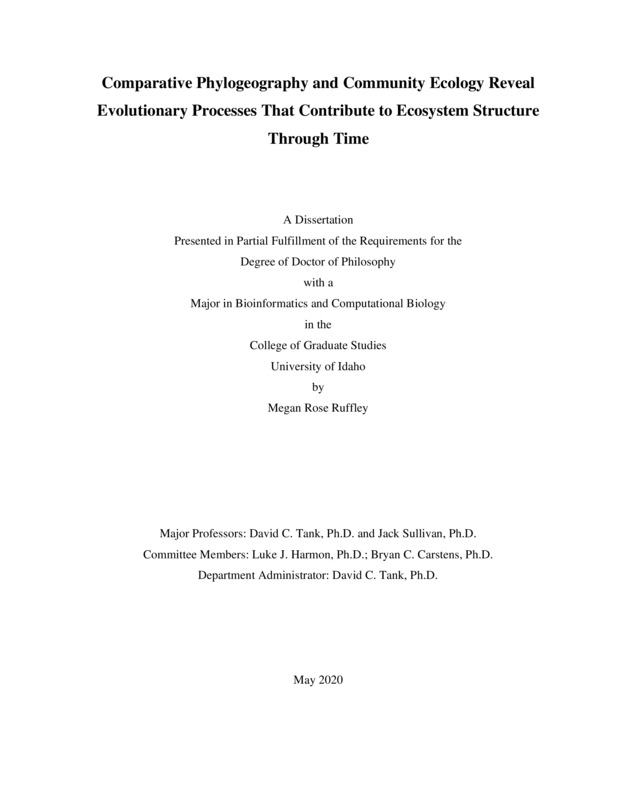Comparative Phylogeography and Community Ecology Reveal Evolutionary Processes That Contribute to Ecosystem Structure Through Time
Ruffley, Megan Rose. (2020-05). Comparative Phylogeography and Community Ecology Reveal Evolutionary Processes That Contribute to Ecosystem Structure Through Time. Theses and Dissertations Collection, University of Idaho Library Digital Collections. https://www.lib.uidaho.edu/digital/etd/items/ruffley_idaho_0089e_11891.html
- Title:
- Comparative Phylogeography and Community Ecology Reveal Evolutionary Processes That Contribute to Ecosystem Structure Through Time
- Author:
- Ruffley, Megan Rose
- ORCID:
- 0000-0003-1796-2719
- Date:
- 2020-05
- Program:
- Bioinformatics & Computational Biology
- Subject Category:
- Bioinformatics; Biology
- Abstract:
-
The research presented here lies at the intersection of phylogeography, phylogenetics, and community ecology and aims to understand how evolutionary processes have contributed to the diversity seen around the world. This diversity is investigated at the population, species, and community level in order to understand the various evolutionary processes that impact these levels. At the population and species level, phylogeographic inference is used to understand when and how populations diverge, maybe due to geographic barriers, and whether they experience gene-flow after said divergence. For this, we specifically investigate plant species in the Pacific Northwest temperate rainforest to understand how geologic and climatic history of the region has influenced the genetic structure of the populations throughout their range. While this is done at the population and species level, inferences across species can be aggregated to make inferences about the community and ecosystem as a whole. To more specifically understand the processes influencing community structure at the community level, we also model the process of many species assembling into a community at once, sometimes experiencing habitat pressure or interspecific competition for resources. We can then use these models to make inferences about the pressures influencing diversity patterns across communities. By investigating evolutionary and ecological processes at the population, species, and community level, we are able to interpret the effect of many different processes impacting diversity at various scales. With the myriad of threats facing all life on earth, being able to use what we know about the impacts of climatic, geographic, and historical processes on evolutionary trajectories will make for better predictions of future sustainability and ecosystem survival.
- Description:
- doctoral, Ph.D., Bioinformatics & Computational Biology -- University of Idaho - College of Graduate Studies, 2020-05
- Major Professor:
- Tank, David C.; Sullivan, Jack
- Committee:
- Harmon, Luke J.; Carstens, Bryan C.
- Defense Date:
- 2020-05
- Identifier:
- Ruffley_idaho_0089E_11891
- Type:
- Text
- Format Original:
- Format:
- application/pdf
- Rights:
- In Copyright - Educational Use Permitted. For more information, please contact University of Idaho Library Special Collections and Archives Department at libspec@uidaho.edu.
- Standardized Rights:
- http://rightsstatements.org/vocab/InC-EDU/1.0/

